Records are meant to be broken. On Sunday, the Argentinian soccer superstar Lionel Messi broke a 40-year-old record, scoring 86 goals in one season. On Monday, the Norwegian chess superstar Magnus Carlsen, 22, won the London Chess Classic in grand style, breaking Garry Kasparov's 13-year-old rating record by 10 points. "Pretty cool," Magnus described the biggest achievement of his chess career.

Looking down from his new stratospheric heights, he must feel like the Swiss balloonist Auguste Piccard who on May 27, 1931 flew nearly 10 miles above the Earth, the first man to see the planet as a round ball. Carlsen can see his nearest rating rival, the former world champion Vladimir Kramnik, looking up.

Carlsen's rating of 2861 will officially appear in the FIDE January rating list. It is not just the number - inflation takes its toll - but the gap he opened on the other players. Vladimir Kramnik is 51 points behind. In 1972, Bobby Fischer was 125 points ahead of Boris Spassky, his nearest contender. Adding inflation, Fischer's rating would hover around 2880 today. Garry Kasparov rose to his record rating of 2851 in 1999, 80 points above Vishy Anand.
The traditional crosstable from the London Chess Classic will be used in the annals of rating history, sealing Carlsen's extraordinary achievement.

Malcolm Pein, the organizer of this wonderful event, loves the soccer system - 3 points for a win, 1 point for a draw. He believes it encourages the fighting spirit, but inviting players who produce exciting chess works for him as well. Carlsen certainly does not need any incentives to play for a win.

The victory in London must be Carlsen's career best. Kramnik matched his own performance from the last year, but it was not enough to outpace Carlsen this time. Nevertheless, Kramnik moved to second place on the FIDE rating list. For the last 20 years, he has been rated among the world's top ten. Michael Adams and Hikaru Nakamura played well and could have scored more points had the breaks gone their way. The world champion Anand, 43, can't get going lately.
Carlsen considered the game against Judit Polgar his best. The legendary Hungarian grandmaster Lajos Portisch once remarked that openings should be played to reach a playable middlegame and Magnus seems to agree. He got a small edge against the Hedgehog system by using a 40-year-old set-up, invented by the highly talented Serbian grandmaster Ljubomir Ljubojevic. Carlsen loves the middlegame and plays endgames with deadly accuracy. His active pieces and a distant passed pawn clinched the victory.

Polgar and Carlsen posing at the London Eye. It was more serious in the tournament hall.
Carlsen,Magnus (2848) - Polgar,Judit (2705)
4th London Chess Classic London 2012
1.c4 c5 2.Nf3 Nc6 3.d4 cxd4 4.Nxd4 Nf6 5.Nc3 e6 6.a3
Preventing the pin Bf8-b4, the pawn move seems like a loss of time, but that's what prophylactic chess looks like: you don't let your opponent do what he usually likes to do.
6...Bc5 7.Nb3 Be7
A preferred square for the dark bishop, but Judit does it only after kicking the white knight from the center.
8.e4 0-0 9.Be2 b6 10.0-0 Bb7 11.Bf4
Bringing pieces into the game first is Ljubojevic's idea from the Sicilian in a similar position. The more straightforward 11.f4 was also successful.
11...d6
The Hedgehog formation in which the black pieces crawl on the last three rows, getting the prickles ready against an anticipated attack. Patience is virtue for white.
12.Rc1 Rc8 13.Re1 Ne5 14.Nd2
The knight assumes a defensive role. Magnus is now fully developed and can think about pawn expansion.
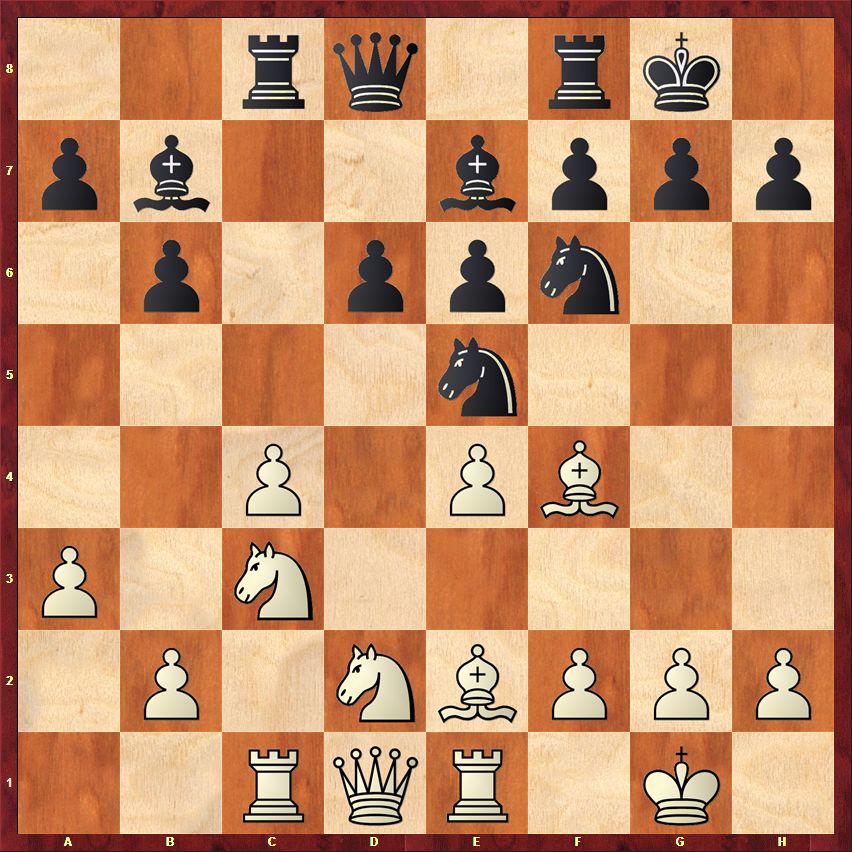
The position has a striking similarity with the game Ljubojevic-Andersson, Las Palmas 1974, after 14 moves:
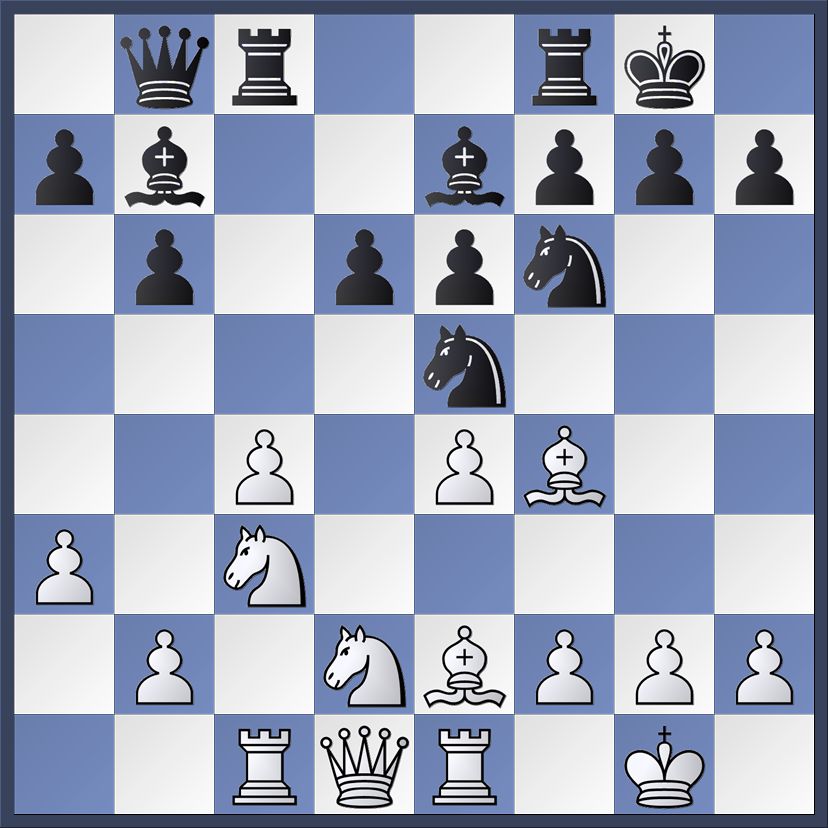
Remarkably, the two positions were reached from two different openings. The small difference lies in the placement of the black queen.
14...Nfd7 15.Be3
Carlsen drops his bishop back, contemplating f2-f4. The game Van Wely-Gashimov, Wijk aan Zee 2012, showed some important ideas for both sides despite being quickly drawn: 15.b4 Kh8 16.Bg3 g5 17.Nb3 a6 18.Bf1 Rg8 19.Na4 Bc6 20.Nd4 Bb7 21.Nb3 Bc6 22.Nd4 Bb7 23.Nb3 ½-½
15...Qc7 16.b4 Qb8 17.f4
And just like that Carlsen grabs space on both wings. He also denies the black knights the squares in the center. Polgar has to live on the last three rows.
17...Ng6 18.g3 Rfe8 19.Bf3 Qa8 20.Bf2 Ngf8 21.Qe2 Qb8 22.Red1 g6?!
Weakening the dark squares. If Polgar wanted to move a pawn in front of her king, she should have chosen 22...h6. Carlsen now gets the space in the center.
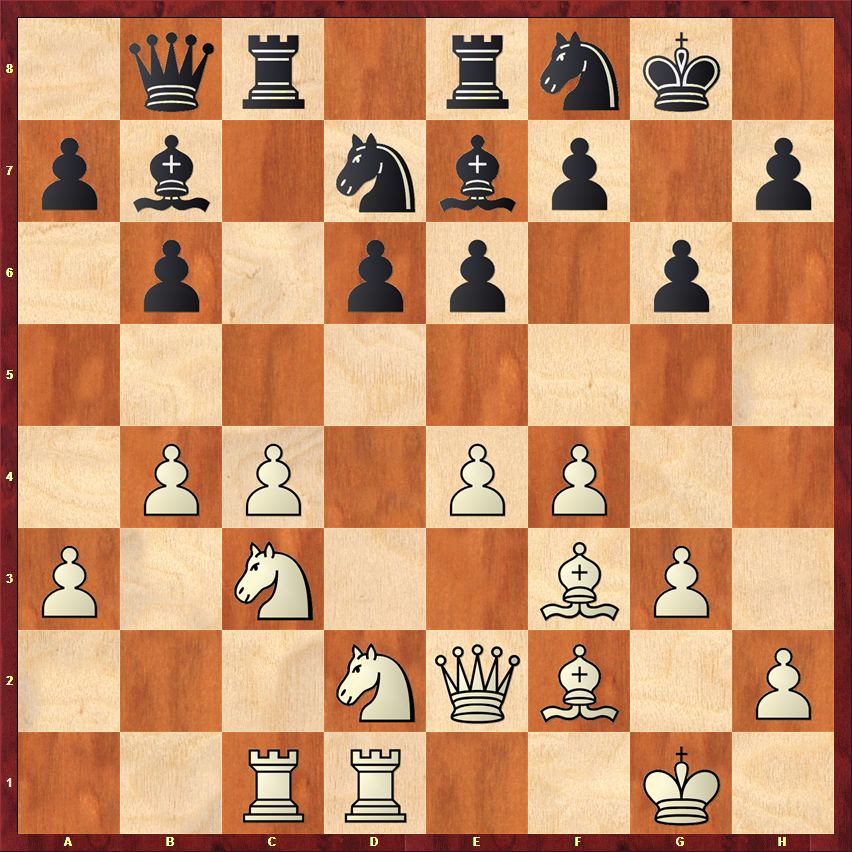
23.e5! Bc6
After 23...dxe5 24.fxe5 Nxe5? (24...Bxf3!? 25.Nxf3 is preferable) 25.Bxb7 black is a piece down.
24.Bd4 Red8 25.Bxc6 Rxc6 26.Nf3 dxe5
Before doubling the rooks on the c-file, Polgar has to exchange the pawns on e5. The immediate 26...Rdc8 runs into 27.exd6! Bxd6 28.Ne4 Be7 29.Ne5 R6c7 (29...Nxe5 30.Bxe5 Qb7 31.b5 wins the exchange.) 30.Ng4 threatening 31.Nh6 mate, white wins material.
27.fxe5
The thorn in black's position, the pawn on e5, is nicely overprotected and the white pieces can enjoy the space behind it. When Aron Nimzovich's idea of overprotecting the e5-pawn first came out, Hans Kmoch published a witty parody in the Wiener Schachzeitung in February 1928.
Nimzovich - Systemsson
1.e4 e6 2.h4 d5 3.e5 c5 4.d4 cxd4 5.h5 Qb6 6.h6 Nxh6 7.Qh5 g6 8.Qh2 Nf5 9.Bd3 Nc6 10.Nf3 h5 11.b4 Bg7 12.Bf4 Bd7 13.Nbd2 Rc8 14.Ke2 Nxb4 15.Ne1 Nxd3 16.Nxd3 Rxc2 17.Rae1 a5 18.Kd1 Rc6 19.Re2 Ke7 20.Rhe1 Re8 21.Nf3
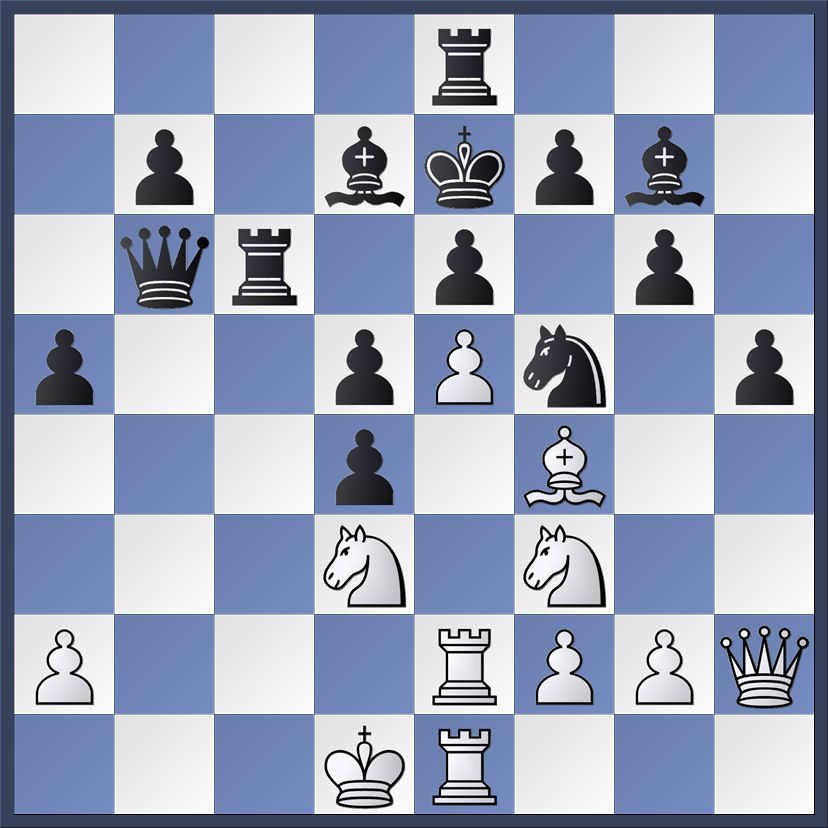
The overprotection fairy tale has to have a happy ending: 21...Bf8 [In the real world black mates in four moves: 21...Qb1+ 22.Nc1 Rxc1+ 23.Bxc1 Ba4+ 24.Kd2 Qc2 mate] 22.g4 hxg4 23.Qh7 gxf3 24.Bg5 mate.
27...Rdc8
The undermining 27...a5 can be met strongly by 28.Ne4! axb4 29.axb4 and capturing the pawn 29...Bxb4? leads to a disaster on the dark squares after 30.Qe3!, for example 30...Bc5 31.Bxc5 Nxc5 32.Nf6+ Kg7 33.Ng4; or 30...Kg7 31.Qf4 h6 32.Be3 winning.
28.Ne4 Qc7
Pilling up the heavy pieces on the c-file gives the impression that black is going somewhere, but the rook on c6 is vulnerable. Magnus has to figure out how to attack it.
29.Nfd2
There goes the overprotection. Magnus needs to swing the knight from e4 to g4 to create direct threats. He even considered the brutal 29.c5 but it leads nowhere after 29...bxc5 30.b5 Rb6 31.a4 (31.Bc3 c4 32.Ba5 Nxe5=) 31...a6 equalizing.
29...a6
29...Nxe5 30.b5 wins the exchange.
30.Nf2
Rearranging the pieces.
30...Bg5
This is the first time a black piece crosses the third rank.
31.Rf1
Magnus detected a weakness in black's camp: pawn f7. The white pawns are less important than the black king.
31...Bxd2 32.Qxd2 Nxe5
Black's best chance. After 32...Rxc4 33.Rxc4 Qxc4 34.Ng4 threatening 35.Nh6+ or 35.Qf4, black's position collapses. Houdini Pro 3 trashes a passive defense: 32...h5 33.Ne4, for example Rxc4 34.Rxc4 Qxc4 35.Nd6 Qc2 36.Qf4 wins; or 33...Nh7 34.Qh6 Nxe5 35.Rxf7!! Qxf7 36.Bxe5 Rf8 37.Ng5! wins.
33.Bxe5 Qxe5 34.Ng4 Rd6 35.Nh6+ Kg7 36.Rxf7+ Kh8 37.Qf2 Qd4
Judit has to exchange the queens to avoid immediate disaster, for example after 37...Rdd8 38.Rb7 black can't stop the devastating fork 39.Nf7+.
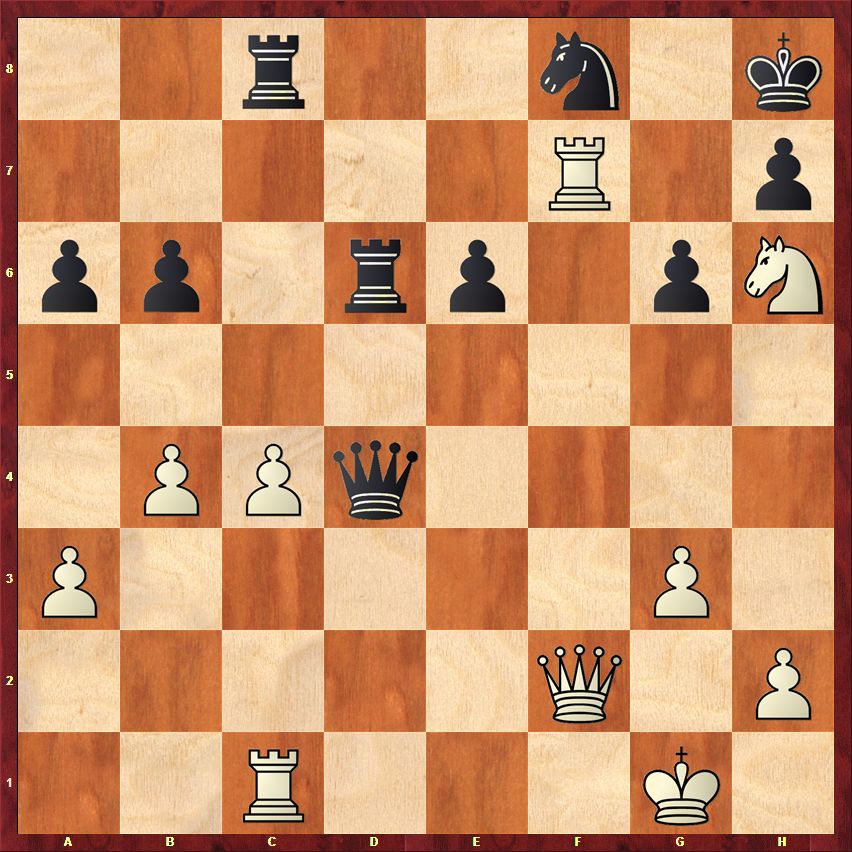
38.c5! bxc5
Exchanging the queens 38...Qxf2+ 39.Kxf2 brings the white king closer to the center.
39.Qxd4+ Rxd4 40.Rxc5 Rcd8
After 40...Rxc5 41.bxc5 and now 41...Rc4 doesn't work: 42.Rxf8+ Kg7 43.Rf4! Rc1+ 44.Rf1 and white is a piece up; and after 41...Nd7 42.c6 Nb6 43.c7 black is locked in and the c-pawn will eventually decide the game.
After 40...Rdd8 41.Rxc8 Rxc8 42.Ng4 Kg8 43.Ra7 wins.
41.Rcc7
The hogs are on the seventh rank and white can eventually create a distant passed pawn.
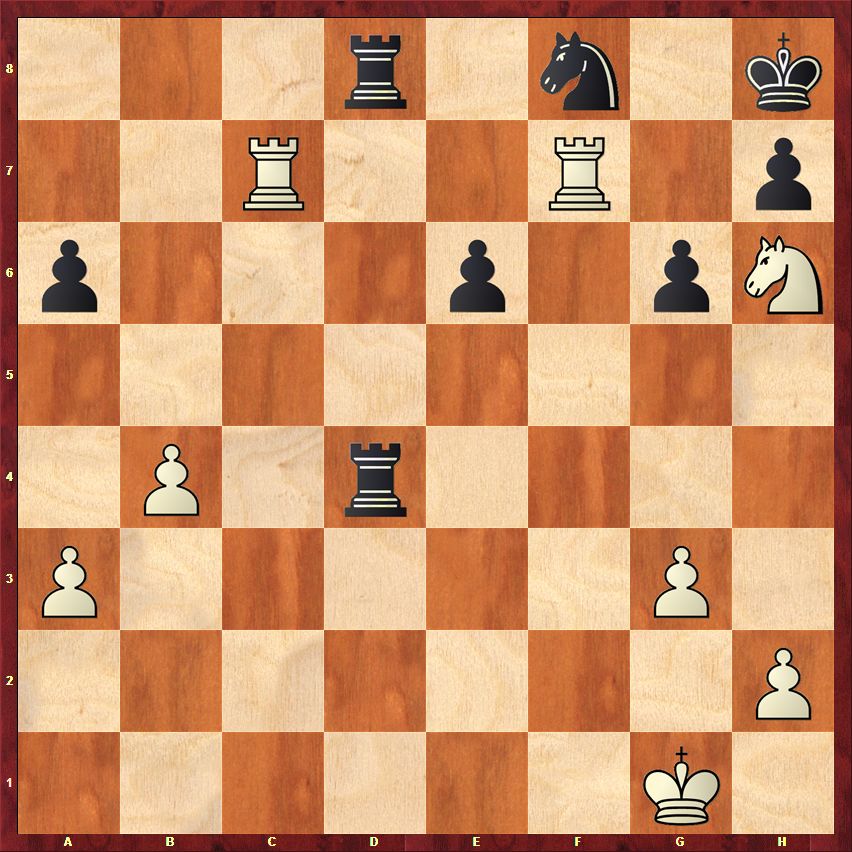
41...Rd1+
It is not easy for Judit to untangle her pieces: 41...R8d7 42.Rxf8+ Kg7 43.Rf7+! wins;
41...R4d7 42.Rxf8+ Kg7 43.Rf7+ Rxf7 44.Nxf7 wins.
42.Kg2 R1d2+ 43.Kh3 R2d5 44.Ng4 Rh5+
After 44...Nd7 comes 45.Re7 h6 46.a4 - Carlsen.
45.Kg2 Rd2+ 46.Kf3 Rf5+ 47.Ke3 Rxf7 48.Rxf7 Rd8 49.Nf6 Rb8 50.Kf4 h6
Forced, otherwise the white king charges to h6, for example 50...a5 51.Kg5 axb4 52.Kh6 bxa3 53.Rg7 a2 54.Rg8 mate.
51.Ke5 a5 52.bxa5 Ra8 53.a6 Black resigned.
After 53.a6 Rxa6 54.Rxf8+ Kg7 55.Rd8 Ra5+ 56.Kxe6 Ra6+ 57.Rd6 wins.
Chess games are fluid. They can flow from one opening to another still keeping the same image as 40 years ago. Ljubojevic and the Swede Ulf Andersson became the architects of the Hedgehog system in the early 1970s. But Ljubo turned around and also proposed how to fight against it with the white pieces. It caught on.
Kavalek,Lubomir - Langeweg,Kick
Wijk aan Zee (4), 17.01.1975
Some of the notes are from my book Wijk aan Zee Grandmaster Chess Tournament 1975 and were written immediately after the game.
1.e4 c5 2.Nf3 e6 3.d4 cxd4 4.Nxd4 Nc6 5.Nb5 d6 6.c4 Nf6 7.N5c3
I wanted to try an interesting idea of Ljubojevic's. Ljubo argued that after 7.N1c3 a6 8.Na3 the knight on a3 is misplaced, black's main point in the Lasker-Pelikan-Sveshnikov variation. Instead, he brings his knights and other pieces closer to the center.
7...b6 8.Be2 Bb7 9.0-0 Be7 10.Bf4 0-0 11.Nd2
Later, Ljubo tried 11.Re1 Ne5 12.Nd2 Nfd7 13.Bf1 (13.Be3 g5) 13...Bg5 14.Bxg5 Qxg5 15.Nf3 Qf6 16.Nxe5 Nxe5 17.Qd2 g5 18.Rad1 Rfd8 19.Qe3 Rd7 20.Rd2 Bc6 21.Red1 Rad8 22.f3 h5 23.Be2 h4 24.Rf1 Ng6 25.g3 hxg3 26.hxg3 Qe5 27.Kf2 Re8 28.Qd4 ½-½ (28) Ljubojevic,L (2590)-Kasparov,G (2630) Tilburg 1981.
11...a6 12.a3

Ljubo's other attempt was 12.Re1 Rc8 13.Rc1 Ne5 14.Bg3 Qc7 15.a3 Rfd8 16.Bf1 Qb8 17.Qe2 Ng6 18.b4 Diagram 1-0 (80) Ljubojevic,L (2615)-Matulovic,M (2530) Zagreb 1975;
12.a3 is Ljubojevic's improvement. In the game Diez del Corral - Kavalek, Montilla 1973, black was fine after 12.Rc1 Nd4 13.Bd3 b5!
12...Nd4
A harmless poke. An interesting plan would be 12...Rc8 followed by 13...Rc8-c7, 14...Qd8-a8, and 15...Rf8-d8.
13.Bd3 Nd7
13...b5? was bad because of 14.cxb5 Nxb5 15.Nxb5 axb5 16.b4 and Black's b-pawn is weak and will eventually fall.
14.Re1
Here goes one of Ljubo's first efforts: 14.Be3 Bf6 15.Rc1 Ne5 16.Bb1 Nec6 17.Re1 Rb8 18.b4 b5 19.Ba2 Ba8 20.Nd5!? exd5 21.cxd5 a5 22.dxc6 Nxc6 23.Qb3 axb4 24.axb4 Ne5 25.h3 Qe7 26.Qb1 ½-½, Ljubojevic-Karpov, Madrid 1973.
14...Ne5 15.Bf1 Bg5 16.Be3 Bxe3 17.Rxe3 f5 18.exf5 Nxf5 19.Rh3

A most difficult position. It looks very strong for black; however, his pawns are split into three "islands," while White's pawns are in two groups. An endgame would be food for White but first he must survive Black's attack.
It is interesting to watch chess players make judgments about different middle game positions. After this game Kick Langeweg told me that he prayed for only one thing:"To be Mikhail Tal!" When I asked why, he replied: "Because he would have won the position after 19.Rh3 very quickly for black."
When I showed the same position to the Yugoslav grandmaster Ljubojevic shortly afterwards, he got excited and his voice rose an octave:"You are better! Look at Black's pawns. They are weak! The rook on h3 prevents everything and once the endgame is reached Black is dead." -lk75
19...Qg5 20.Nde4 Bxe4
After 20...Qf4 21.Qd2 White can force the exchange of queens, for if 21...Qg4 22.Be2 Qg6 23.Bh5 Qh6 24.Bf7+ and White wins the queen. Now, with the exchange of the bishop for the knight, an important piece in Black's attack is removed. - lk75
21.Nxe4 Qf4 22.Qe1
The critical position. White needs one more move (23.Ra1-d1) to consolidate. - lk75
22...d5?!
An aggressive move, giving White the opportunity to counter-attack. After 22...Rac8 white can choose between 23.b3 d5 24.cxd5 exd5 25.Nc3 with play proceeding in a similar way as in the game, and the very complicated line 23.Rd1 Nxc4 24.Ng5. During the game I thought 22...Ng4 posed the most danger. - lk75.
23.cxd5 exd5 24.Nc3 Rad8
After 24...Rae8 White replies 25.Nxd5 and if then 25...Nf3+ 26.Rxf3 Rxe1 27.Rxe1 Qd2 28.Re5 White has enough compensation for the queen. - lk75
25.Rd1 d4
After 25...Rfe8 White calmly plays 26.Rxd5 lk75
26.Nxd5 is even stronger with the idea 26...Nf3+?! 27.Rxf3 Rxe1 28.Rxf4 Rxd1 29.Rxf5 R8xd5? 30.Rxd5 Rxd5 31.Bc4 and the pin wins.
26.Qe4 Ng6?
Losing at once. Black saw the queen move 26.Qe4 too late. Perhaps the endgame, after 26...Qxe4 27.Nxe4 would not have been lost for him. - lk75
27.Qe6+ Rf7
Black has no choice. After 27...Kh8 28.Qxg6 Nh6 29.Qg3 White wins a pawn. - lk75
28.Rf3 Qg5
Black goes for a desperate attack, easily refuted by accurate moves. After 28...Qe5 29.Bc4 Nd6 30.Ne4 White wins easily. - lk75
29.Bc4 Ngh4 30.Qxf7+ Kh8 31.Rg3!
Blunting the attack.
31...Nxg3 32.hxg3 dxc3 33.Re1!
The point of white's combination - Black loses a piece.
33...Qg6 Black resigned, not waiting for 34.gxh4.
Note that in the replay windows below you can click either on the arrows under the diagram or on the notation to follow the game.
The column was prepared with ChessBase 12 and we used a cool new feature to search the games. The analyses were checked by Houdini 3. Both tools are invaluable for tournament players and chess writers.
Photo images by Ray Morris-Hill
Correction: The article incorrectly stated that Lionel Andrés "Leo" Messi is an Italian soccer superstar. He is from Argentina.
